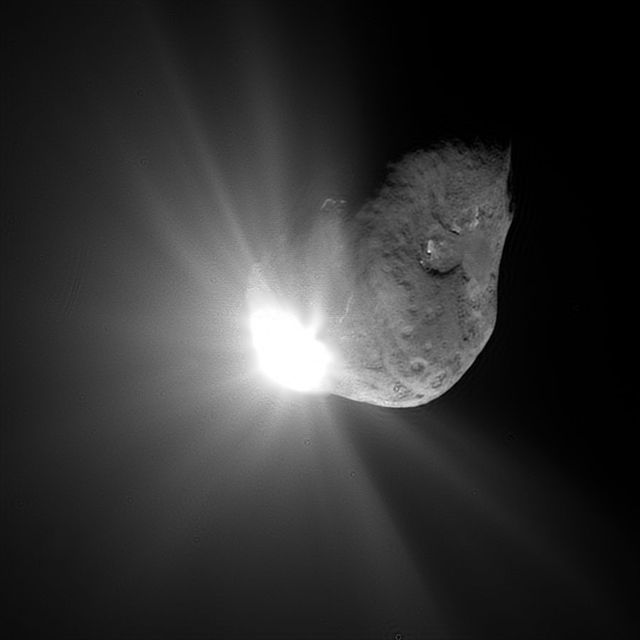Comets are space bodies that are found within the Solar System. They are made up of ice, rock and dust, they orbit the Sun and they come from both Oort Cloud and Kuiper’s Belt. Their typical tail appears when approaching the Sun, because their surface heats, particles of dust and ice are expelled by solar wind to space, reaching a length of up to several million kilometers.
Yet since the 80’s, EEUU, URSS and Japan have sent space probes to these space travelers, in order to figure out their composition, fact that has opened the door to the undisclosed and unexpected secrets of the origin of life on Earth. Comets’ composition include all the elements that are required for supporting terrestrial life, and it is believed that the impacts of the comets against the young Earth might have helped to complete the Primordial Soup, which was the origin of life as we know it.

Comet Tempel 1 67 seconds after it collided with Deep Impact
Missions such as Deep Impact, Deep Space (NASA), Suisei (JAXA) and Vega 1 (Sovietic Spatial Program) are aiming to deepen more in the history of these sleeping giants, reaching the point of impacting with them on purpose in order to cause an explosion that would expose its nucleus to the sensitive photographic cameras, such is the case of the Deep Impact, which in 2005 approched the comet 9P/Tempel_1, and thanks to an impacter of about 375kg, a 150m crater was caused. This process was captured by the rest of the space probe.
Nevertheless, the first spatial probe that adopted and followed the orbit of a comet, placing itself only 100km from it, was the probe Rosetta, launched by the ESA with the intent of studying the comet 67P/Churyumov-Gerasimenko. ESA has sent a landing module that will land on the comet’s surface. The module has several tools for studying the space body, among them, a drill aimed to collect internal samples. In order to correctly approach to the comet, it was required to perform a complex travel through the orbit of several planets and the sun so an optimal gravitational assistance was achieved, otherwise the amount of fuel required for this trip would have made the mission unfeasible.
The name of this space probe was inspired by the Rosetta stone, which allowed to unravel the mysteries of Egyptian Hieroglyphs, and a parallel expectation is focus on Rosetta’s mission to reveal the misteries of the Solar System.
Space probes behave as the eyes of the human kind at those places where our bodies cannot survive, and they allow us to know everything that for centuries belonged to the Kingdom of dreams. For years, these small mechanical adventurers have gone far beyond our expectations, and have raised our hope of unraveling the deepest secrets of Space.

